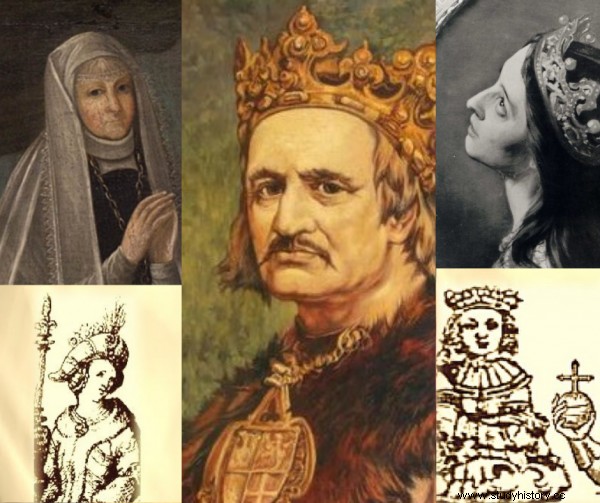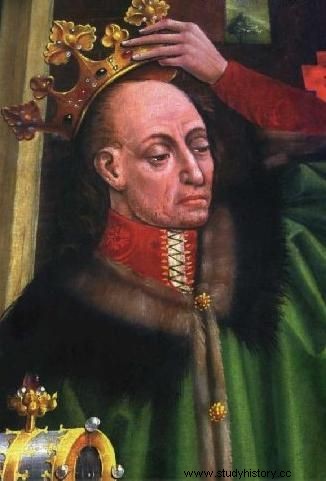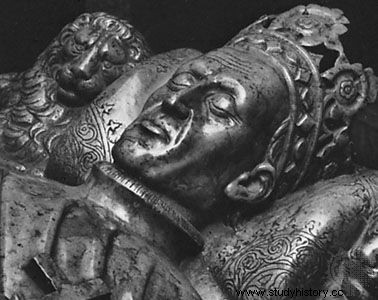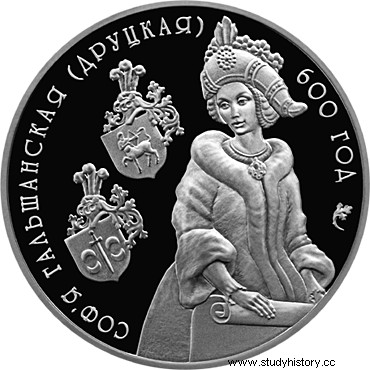Władysław Jagiełło was one of the most long-lived rulers in the history of Poland. However, the same cannot be said for his wives ...
At the time of his death, the Lithuanian could be over eighty years old, which would almost double the average life expectancy at that time. Although we do not know the true age of Jagiełło at the time of his death, historians agree that he lived a long life in good health. This was due as much to his genes as to his healthy lifestyle ... Unfortunately, there is also agreement on the misfortune that the ruler had for his spouse. He had four of them, of which only the last one survived the king! 
As if that were not enough, the last queen did not die of natural causes, leaving the world at the age of fifty-six. This is the story of Władysław Jagiełło's troubled marriages.
The Mysterious King
History knows Władysław Jagiełło only from the moment when he ascended the throne of Poland through his marriage with Jadwiga Andegaweńska. It is not known how old he might have been then. As we read in Lords of Poland. A story re-told :
Jagiełło was the son of Grand Duke Olgierd. Historians are still arguing which in turn. Disputes arise from the fact that it is not known when he was born. Older historiography claimed that around 1352, the newer one proves that even around 1362
According to all descriptions, he was not very tall, but slim, had a long face with small eyes. The passage of time was not harsh on him, he belonged to people who were "aging nicely" even though he got quite bald with age.

Władysław Jagiełło led a healthy lifestyle
Importantly, he was also very lively and always full of energy. He loved being outdoors, always taking the opportunity to hunt. He was not terrible heat or cold - and the hunters then had to endure much more than today! We should also remember that Jagiełło hunted in the times when firearms had not yet been invented, i.e. with a bow, javelin and ax. Direct clashes with animals, hours of waiting for the appearance of beavers or the approach of pheasants in the rain were nothing unusual. And yet - Władysław planned all trips so that on the way there was time for a trip to the forest.
Sport and diet
The second, important, according to modern historians, issue was, of course, diet. The cuisine served at Jagiełło's court was not as saturated with fat and sugar as that characteristic of Sarmatian Poland. And although the king was known for his lavish reception of guests, he himself acted in moderation, against the assurances of Jan Długosz, drinking mainly water and eating sweets in secret and in small amounts. The table was therefore dominated by meat, fruit and vegetables, and Władysław was supposed to dislike only apples. He was also attributed a great love for Lithuanian specialties:dumplings with cheese, borscht, parsnip soup and goose giblets.
Długosz (not very favorable towards Jagiełło) also mentions that the king slept a lot and did not hesitate to rest after a meal. The older he got, the longer he slept - so much so that at a certain age he began to miss the morning service. It was also famous for its high hygiene :he used the baths a few times a week and sent his courtiers there, had the sheets washed frequently, and was always clean-shaven.

Władysław Jagiełło took care of his diet, hunted a lot and did not drink alcohol
[...] the king did not drink alcohol, he moved a lot and stayed outdoors, he slept well, he bathed every other day in a copper tub in the shape of a horse, which he took with him on his travels. No wonder that throughout his life he kept a slim figure, in good condition, and did not have many reasons to complain about his health.
- writes Wika Filipowicz in the book At the table with the king . The good health accompanying the king until his old age is best evidenced by the fact that, even at the age of eighty, he did not avoid hunting. Even his name (originally probably Jogaila or Jagajło), meaning simply "strong rider" or "best of all", spoke a lot about this extraordinary physical prowess. He traveled often, visited his native lands and sought peace in the bosom of nature. And he certainly needed peace, given the turbulent history of marriages ...
Bad times to give birth
Jadwiga Andegaweńska was the first and, it seems, favorite wife of Jagiełło. No wonder! One of the many advantages must have been her extraordinary beauty. What's more, she shared many interests with the Lithuanian. She rode horses, liked being outdoors, and was not afraid of long journeys. At first, she was not even too concerned about the prevailing trend of "mortification" by enjoying life and wearing the hair shirt only occasionally.
Unfortunately, the role of a woman - even at the side of the king - was then mainly to bear children. And those, as if out of spite, were not there. This would soon become a source of conflicts in the royal marriage. What's worse, Jagiełło used to look for nerve relief during numerous trips, so there were fewer and fewer opportunities to procreate.

Jadwiga Andegaweńska was an extraordinary figure and, according to some, Jagiełło's favorite wife
Some even said that Jadwiga's infertility was a punishment from God for breaking her earlier engagement with William Habsburg.
Following the "good advice" of the people around her, the Queen took a little more care of her spiritual sphere. She fasted more often and prayed a little more earnestly until… it worked! Whether it was due to the placebo effect, or perhaps, according to malicious commentators, with the participation of third parties, a descendant finally appeared in Jadwiga's womb.
The girl, however, turned out to be the undoing of Jagiełło's unfortunate wife. The baby was weak and died three weeks later. The mother died four days later. According to modern researchers, the reason could be too small spacing of the iliac plates, i.e. to put it bluntly - too small a pelvis. The difficult childbirth strained Jadwiga's strength. To make matters worse, she developed puerperal fever as a result of an infection. The medical knowledge at that time was too little for any attempts to save the queen to have the desired effect. It did not help that the hands and surgical instruments were not washed at the time.
Death in solitude
Władysław's second marriage was, in short, very unsuccessful. Anna Cylejska, presented to the ruler by matchmakers, was not very pretty and had unpleasant family experiences behind her. The king did not hide his dissatisfaction with his new wife, and she was saved from sending her on the way back only through the intercession of Lithuanian advisors.
Regardless, during the next fourteen years Jagiełło avoided his wife's company like fire by sending her to a monastery or by escaping on another expedition. Nevertheless, in 1408, Jadwiga Jagiellonka - Władysław's second daughter - was born, who lived twenty-three years and died unexpectedly from disease or poison.

Władysław Jagiełło was in perfect health. Unlike his wives.
In 1415, news about Anna's illness reached Władysław, who was in Lublin. According to reports, he did not care much about it and continued his march to Krakow at a normal pace. The queen died the day after his return. The exact reasons for her departure are also unknown to us - the sources say about an undefined disease that consumed her body for several months before it led to her death.
Strange marriage
The third wife of Władysław, in the opinion of many people living at that time, did not fit the king. Paradoxically, it was the over forty-year-old Elżbieta from Pilcza Granowska that Jagiełło chose for himself. There were many guesses about the features of the woman that attracted the king, including accusations of witchcraft. Apparently, despite her age, she kept her beauty and was almost as beautiful as Radziwiłłówna.

Elżbieta née Pileckich Granowska - the third wife of Władysław Jagiełło
The problem was that the three-time widow and mother of many children suffered from a chronic disease at the time of her marriage with Jagiełło. Exhausted, she died of tuberculosis in 1420. There were still no new descendants - candidates to extend the royal line. Władysław must have been seriously worried about his heritage…
Fresh blood
The last queen alongside Władysław was Zofia Holszańska - a Lithuanian woman, an energetic and good-looking girl at the age of ... seventeen! No wonder that already aged Władysław sometimes treated her more like a granddaughter than a wife. This, however, did not prevent the couple from begetting offspring (although there were also various rumors about this). In the end, two sons were born to the king - Władysław Warneńczyk and Kazimierz Jagiellończyk. The middle child, born right after the Varna, unfortunately died. The other boys, thankfully, both were healthy:the relationship between Władysław and Zofia was dangerously close, and some indications say that the queen could even be the king's niece.
Władysław's last marriage seems to be happy from a historical perspective. Beautiful and young Zofia spoke Jagiełło's native language, which must have been a nice change. There are also letters that prove (at least in writing) a real feeling. Further rumors about the illegitimate origin of the young Władysław and Kazimierz obviously had to appear, but the queen was finally cleared of all charges. Besides, Jagiełło, despite his advanced age, was still robust, as evidenced by the constant hunts he went on.

Władysław Jagiełło was buried at Wawel
It had lost him, anyway. He didn't care about his age.
At the beginning of 1434, Jagiełło set out on his way to Halicz, where he was to receive a feudal tribute from the Moldavian hospodar. During a stop in the village of Medyka, the king, as was his custom for many years, went to the forest and spent half the night there, not properly clothed.
- we read in Royal Plagues Karolina Stojek-Sawicka. He did not cure himself from a cold. According to Długosz's accounts, two months later the king "fell asleep as gentle as possible in the hands of the clergy and lay masters" .
Killer Melons
Zofia Holszańska survived Jagiełło and took an active part in further political events. At fifty-six, she died suddenly of ... poisoning from eating too many melons.

A collector's coin of the National Bank of the Republic of Belarus, designed by Svetlana Zaskiewicz, depicting Zofia Holszańska (2006)
The court doctors tried to cure Władysław's widow, but she refused to take any medications. One of the last symptoms of the disease was paralysis, which may indicate a stroke. She even managed to survive her own son, Władysław. At the time of Zofia's death, the younger Kazimierz took the throne of Poland and Lithuania.
